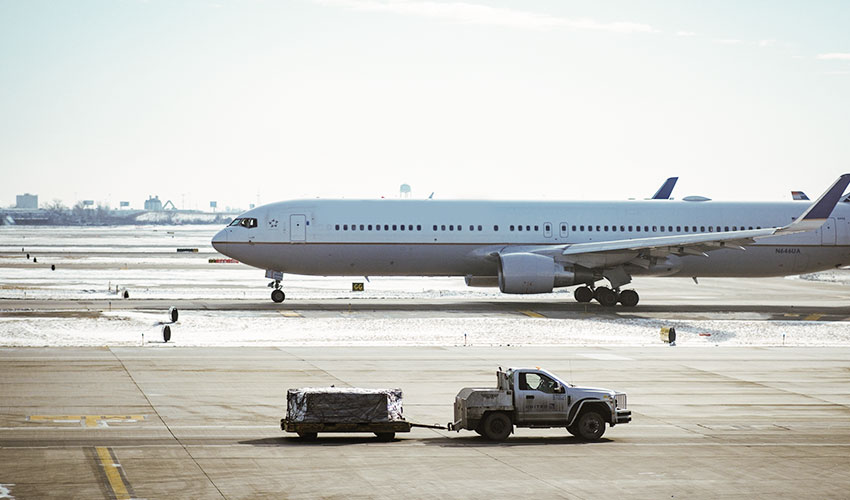Winter is coming! This season is the favorite of many for several reasons. It is a time to play around in the snow, ski, snowboard, gather with the family, celebrate the New Year with friends, and much more. For airlines, however, the colder months bring some challenges. While winter in the northern hemisphere officially starts in December, the aviation winter season, or, as we call it, the de-icing season, generally starts in October. By then, qualified staff and specially designed vehicles have to be ready for the crucial task of removing snow, ice, and frost from the aircraft´s surface.
What Makes De-icing so Critical?
Well first of all it is a matter of safety for passengers and crew. Airplanes must have clean surfaces to fly safely. Any type of contaminant such as ice has the potential to interfere with a safe take-off due to the disruption of air flow (a quarter-inch-thick layer of ice on a plane is enough to disrupt the way air flows over its wings). Thus, the application of anti-icing is paramount, not only to remove frost, snow, and ice but also to delay the reformation of ice or facilitate its removal, as the substance remains on the surface for a certain period.
On the other hand, from an operational perspective, inefficient de-icing processes on the ground can result in major flight delays and cancelations. It is estimated that about 60,000 flights get canceled each year because of cold temperatures, which costs airlines and airports around $3 billion. The nature of de-icing demand forces aviation entities to be ready to react on very short notice, which is often very challenging due to:
- The lack of reliable weather predictions making it hard to accurately predict in advance when the de-icing process should take place.
- Clear communication and coordination of activities not always being the case as different stakeholders are involved.
But do not worry, there are some ways you can optimize your de-icing process.
Our Expert Tips for the De-icing Season
1. Start Preparing On Time
Preparing for the aircraft de-icing season in advance is crucial to ensure smooth operations, enhance safety, and maintain efficiency. Weather conditions can be unpredictable, especially during colder months. By preparing early, ground handlers can establish protocols for varying weather scenarios and ensure that personnel are trained and ready to respond to changing conditions. This flexibility is critical for adapting de-icing plans on short notice.
Another important point to ensure operational readiness is maintenance. De-icing equipment needs to be regularly inspected and maintained for optimal performance. Advance preparation allows for personnel to conduct thorough quality checks, perform necessary maintenance, and address any issues with equipment functionality before the season begins.
2. Match the Available Resources with your Operational Needs
It is estimated that aircraft de-icing can extend the ground handling time by 15 minutes on average. However, depending on the weather conditions, de-icing requirements can vary, which can potentially affect the aircraft´s waiting time on the tarmac. In order to be able to react to such operational requests in a timely manner, it is important to have the right resources in the right place.
An efficient deployment of resources can be achieved by optimizing the schedule of staff and vehicles. This, rather than following First Come First Serve principles where the sequence of deicing, is determined by the time of the request. When available resources are allocated based on variables such as flight priority and individual slots, higher traffic volumes can be handled without compromising service level agreements (SLAs).


The airport infrastructure also plays an important role. The efficient utilization of gate de-icing and remote de-icing pads should be in line with the optimized utilization of de-icing vehicles.
Finally, you also have to consider the individual requests of pilots during the de-icing season, All these aspects have to be managed within the short timeframe of an aircraft turnaround.
3. Improve Stakeholder Communication
Aircraft de-icing is a complex and safety-critical process. It involves multiple parties with varying interests and responsibilities – airport, airline, ground handler, as well as air traffic control. Effective communication among these stakeholders helps ensure the safety of flights, the efficiency of operations, and the overall success of the de-icing process.
How can you ensure the provision of the right level of data at the right time? One way to do that is with the integration of flight and weather information to improve operational awareness and transparency. Electronic means to record pilot requests can help to reduce voice communications. Last but not least, electronic recordings of the different de-icing process steps can facilitate the tracking of de-icing activities.
Advanced Technology Supports De-icing Operations
The optimization of the de-icing processes at the airport can be facilitated thanks to advanced software solutions:
- The timely use of resources and data is fundamentally crucial in order to minimize the impact of cold weather on aircraft departures.
- Advanced solutions analyze historical data, weather forecasts, and flight schedules to predict peak de-icing demand periods. By using this information, staff and equipment can be allocated more effectively, ensuring they are available where and when they are needed.
- Real-time monitoring capabilities allow supervisors to track the progress of de-icing operations, ensuring that they stay on schedule while identifying any bottlenecks or delays in the process.
- Software optimization also can support the de-icing season with the optimization of the refueling of de-icing liquids. This minimizes fluid waste and additional costs during operations.
The utilization of integration platforms, resource optimization tools, and AI to enhance predictions will help you to be better prepared for bringing travelers to their families on time for the holiday season.





0 comments on “Let It Snow! Expert Tips for The De-icing Season”